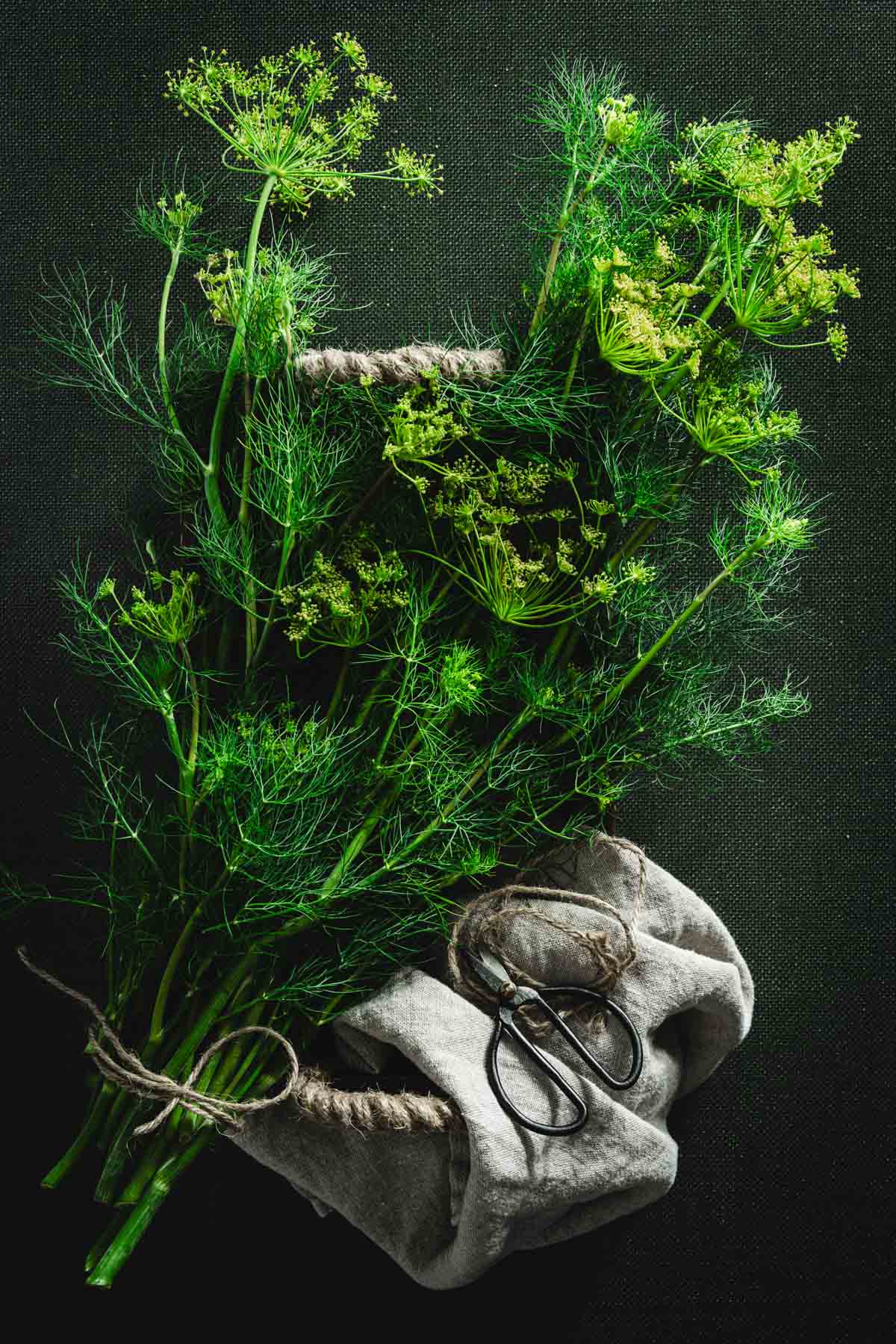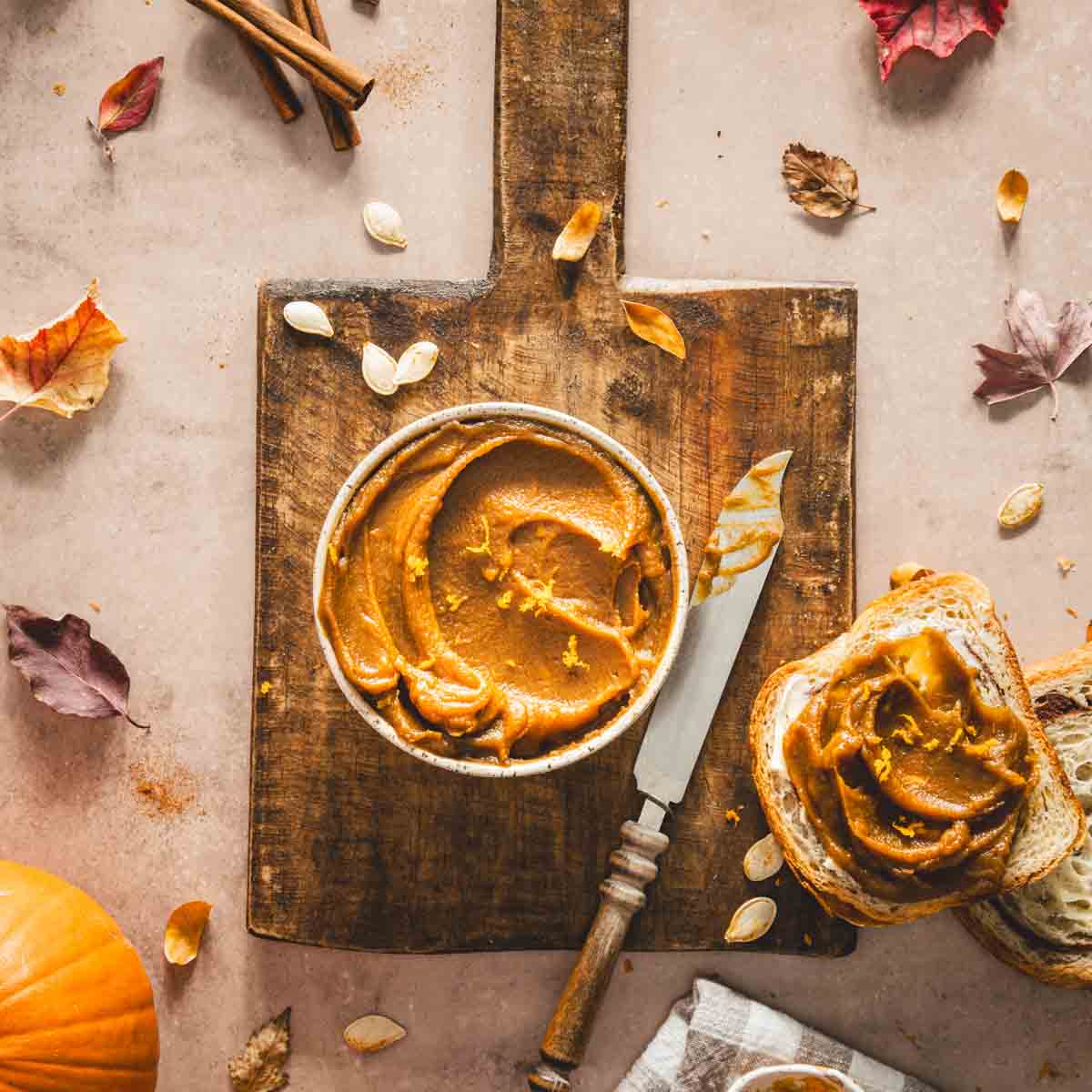Fresh Dill infused Oil
With an abundance of fresh dill, I decided to make Fresh Dill infused Oil. Preserving the herbaceous flavor of dill sounded like the perfect idea.
I must say, it was a genius one 🙂

With only 3 ingredients, this recipe is perfect to make any time, but especially when fresh dill is in season.
Why you will love this recipe
Freshness and flavor – the vibrant, fresh taste of dill is perfectly captured in homemade dill oil, offering a burst of flavor that enhances any dish.
Versatility – dill oil can be used in very many ways. It truly is my kitchen staple.
Health benefits – dill is known for its digestive benefits and antimicrobial properties. Using dill oil adds a healthy twist to your meals.
Customizable – when making it at home, you can adjust the intensity of the flavor to your preference and experiment with different oil bases.
Gourmet touch and aesthetic appeal – especially important for food bloggers and food photographers 🙂
Preservative-Free – homemade means no artificial preservatives or additives, just pure, fresh ingredients.
Ingredients, Variations, and Substitutions

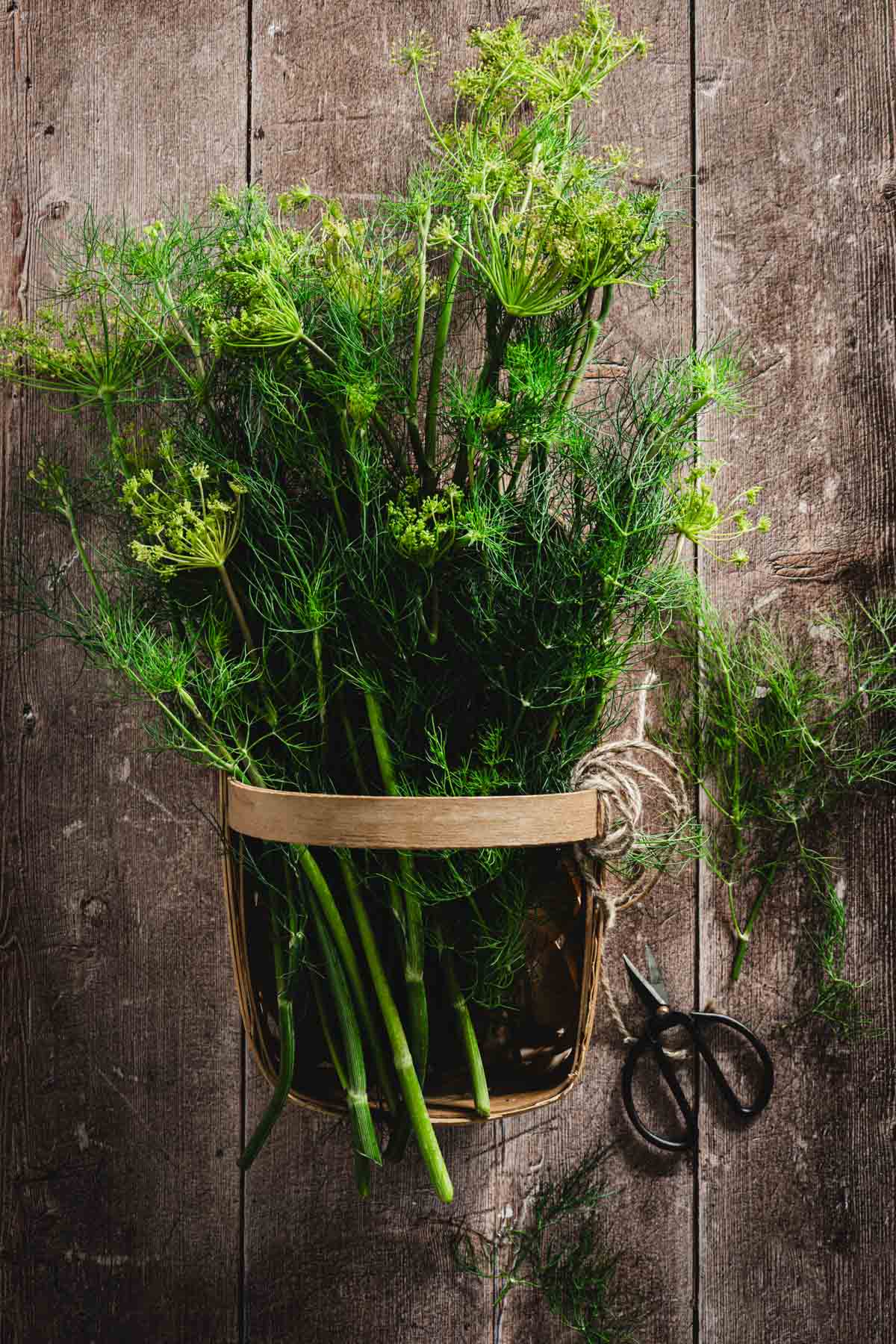
Fresh Dill Leaves – also known as dill weed, have a fresh, slightly tangy flavor with hints of anise and parsley. Ensure the dill is thoroughly washed and dried to avoid water in the oil, which can spoil it. Fresh dill gives the best flavor, but dried dill can be used in a pinch (though the flavor will be less intense). Fennel fronds or fresh parsley can be used if dill is unavailable, though the flavor profile will change.
Neutral Oil (Grapeseed, Sunflower, or Light Olive Oil) – neutral oils have a light flavor that allows the dill’s taste to shine through. Choose a high-quality oil with a mild flavor. Avoid oils with intense flavors, like extra virgin olive oil, which can overpower the dill. Canola or avocado oil can also be used, as they are similarly neutral in taste.
Salt – a pinch of salt enhances the flavor of the dill oil. Adding salt is optional and should be done sparingly to taste. You can omit the salt or use a tiny bit of sea salt or Himalayan pink salt for a different nuance.
Equipment you will need
- Blender or Food Processor
- Fine Mesh Strainer or Cheesecloth
- Mixing Bowl
- Sterilized Jar or Bottle with a Tight-Sealing Lid
- Saucepan (if opting for the cooked method)
- Tongs and Ice Bath (if blanching the dill)

Top Tips
Use fresh dill – fresh dill leaves provide the best flavor and aroma. Ensure they are bright green and not wilted. Rinse the dill thoroughly and pat it completely dry to prevent water from mixing with the oil. I left them spread out on a baking sheet overnight.
Choose a neutral oil – grapeseed, sunflower, or light olive oil will allow the dill flavor to stand out.
Blanch the dill – to preserve its bright green color and help lock in its fresh flavor.
Blend thoroughly – a thorough blend ensures maximum flavor extraction and a smoother texture. Blend the dill and oil until the mixture is as smooth as possible.
Strain well – the key to clear and smooth oil! Use a fine mesh strainer or cheesecloth and press down on the solids to extract as much oil as possible. I also strained a second time using a paper towel.
Sterilize storage containers – clean containers prevent contamination and extend the shelf life of the dill oil.
Proper storage – store the oil in a tightly sealed container in the refrigerator. It should keep for about two weeks.

Step-by-step instructions
- Wash and sort the fresh dill.
- Bring a pot of water to a boil, and in a separate bowl, prepare an ice bath (a bowl of ice water).
- Blanch the dill in the boiling water for about 10-15 seconds.
- Immediately transfer the dill to the ice bath to stop the cooking process. This helps retain the bright green color of the dill.



- Pat the dill dry with paper towels. Make sure it’s completely dry to avoid any water mixing with the oil. I left mine drying overnight on a baking sheet lined with a paper towel.
- Transfer the blanched dill and oil to a high-speed blender or food processor.
- Blend until the mixture is smooth.

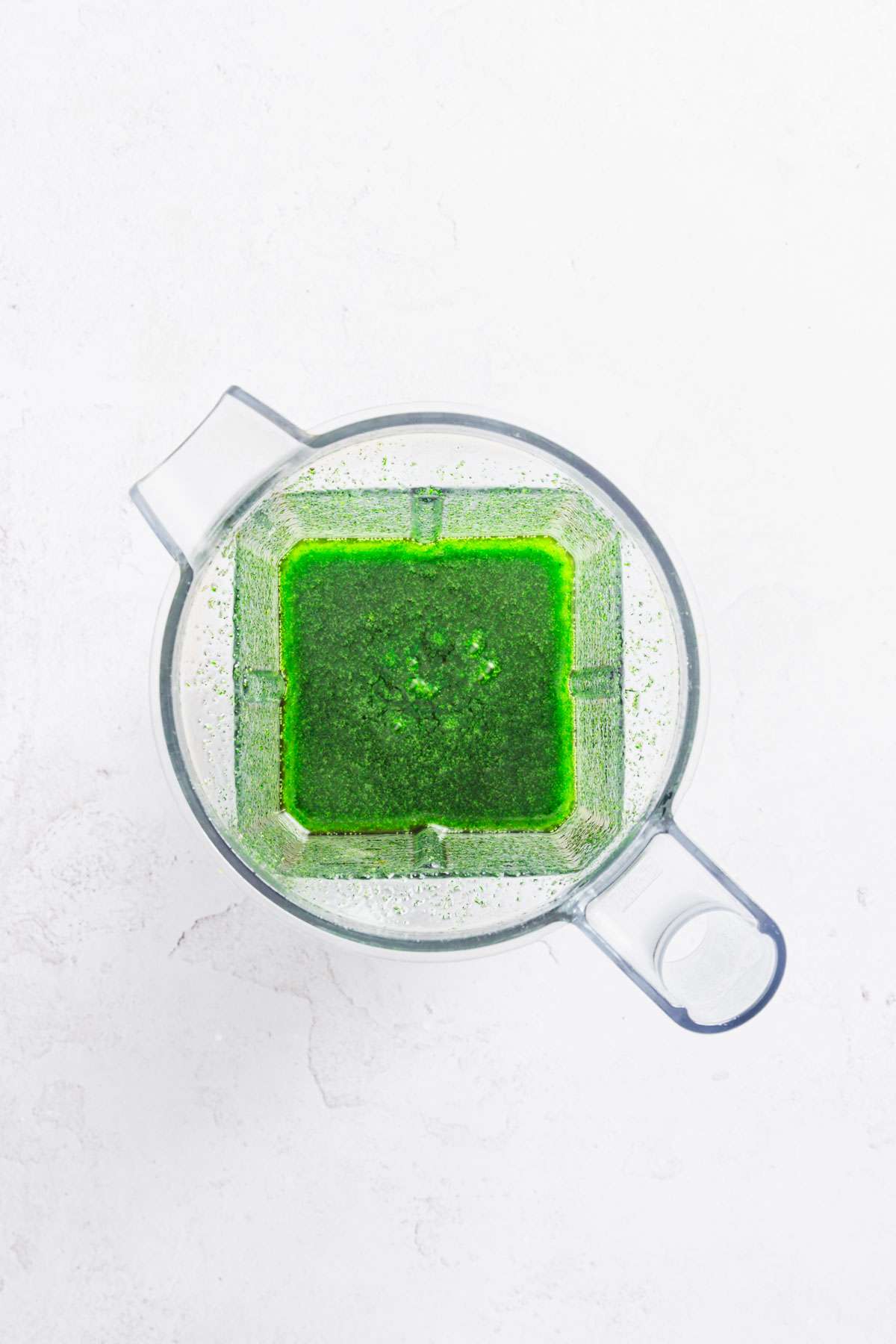
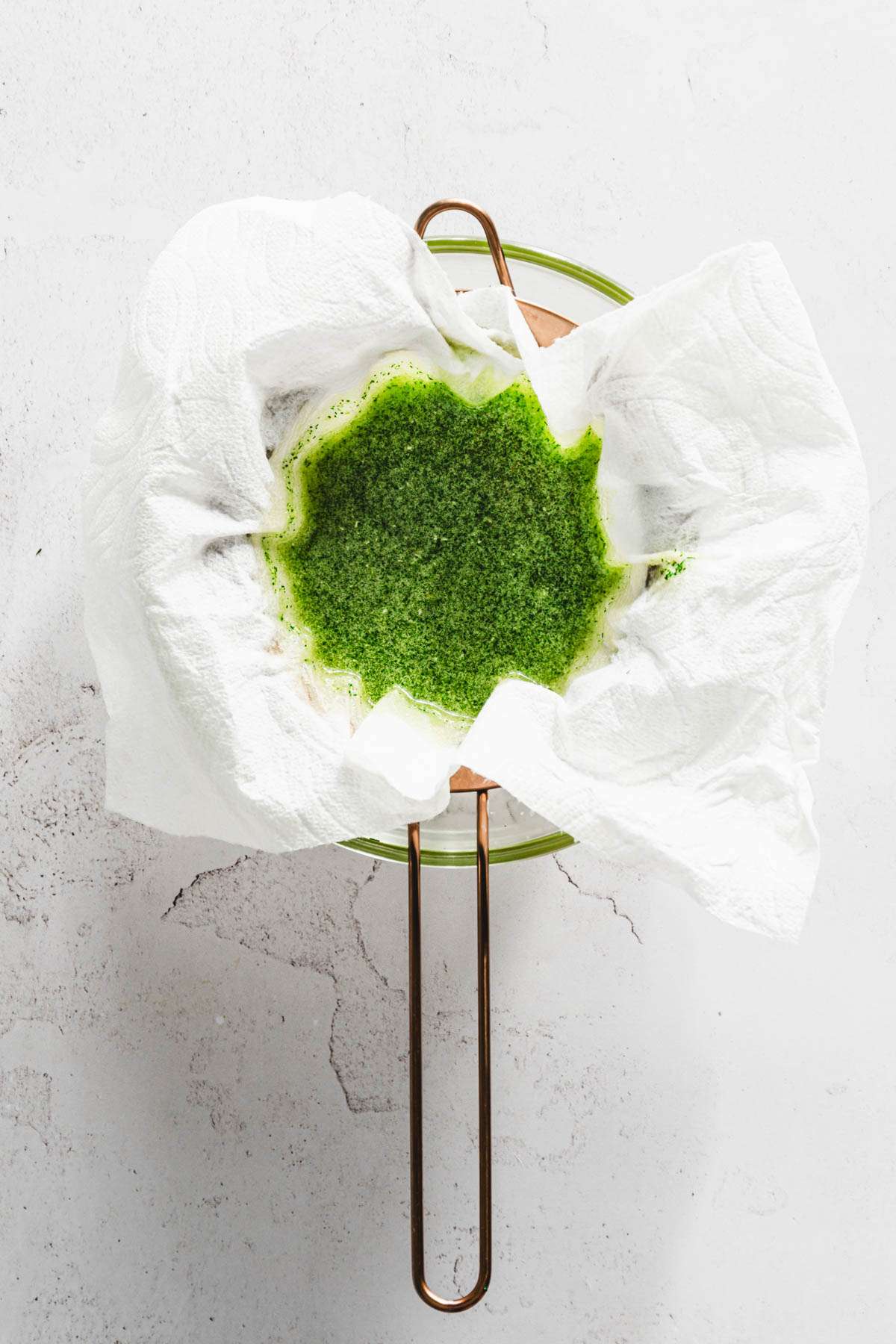
- Use a fine mesh strainer or cheesecloth to strain the oil into a clean jar or bottle, pressing out as much oil as possible.
- Discard the solids left in the strainer.
- Pour the strained dill oil into a sterilized jar or bottle.
- If desired, add a pinch of salt for seasoning.
- Seal the container tightly and store it in the refrigerator.
How to best enjoy Dill-infused oil
Salads – drizzle it as a finishing touch or use in vinaigrettes or homemade dressing.
Vegetables – enhance the natural sweetness of roasted or grilled veggies.
Seafood – this delicate oil pairs perfectly with fish and shellfish.
Soups/Stews – add depth of flavor to creamy and hearty dishes.
Grains/Pasta – mix dill oil with cooked grains or pasta to infuse them with a subtle and aromatic flavor.
Make pesto or hummus with it
Marinade – use this oil as a marinade for meats and veggies.
Eggs – add a fresh twist to breakfast.
Appetizers – garnish for enhanced flavor and presentation.
Yogurt/Dips- mix for added flavor and texture and enjoy with pierogis.


You may also like:
Storage instructions, reheating
Refrigeration:
- To prevent contamination and extend the shelf life of the dill oil, wash the jar or bottle with hot, soapy water, rinse well, and dry completely before use.
- Store the strained dill oil in a tightly sealed jar, bottle, or airtight container in the refrigerator.
- Dill oil should keep for about 2 weeks in the refrigerator.
Freezing (Optional):
- Pour the dill oil into ice cube trays and freeze. Once frozen, transfer the cubes to a freezer-safe bag or container.
- Can be stored in the freezer for up to 3 months.
Reheating Instructions:
Homemade dill oil typically doesn’t require reheating, as it’s usually used cold or at room temperature. However, if you prefer to warm it slightly for certain applications:
- Room Temperature:
- Take the jar or bottle from the refrigerator and let it sit at room temperature for about 30 minutes to an hour.
- Gentle Warming:
- Place the jar or bottle of dill oil in a bowl of warm (not hot) water for a few minutes until it reaches the desired temperature.
- Avoid microwaving or direct heat, as this can degrade the flavor and nutritional properties of the oil.



Fresh Dill-infused Oil
Equipment
- blender or food processor
- fine mesh strainer or cheesecloth
- mixing bowl
- jar or bottle
- saucepan for blanching
- tongs and ice bath
- baking sheet, paper towel for drying the blanched dill
Ingredients
- 1 cup fresh dill leaves
- 1 cup neutral oil sunflower, grapeseed, light olive oil
- salt optional
Instructions
- Wash and sort the fresh dill.
- Bring a pot of water to a boil, and in a separate bowl, prepare an ice bath (a bowl of ice water).
- Blanch the dill in the boiling water for about 10-15 seconds.
- Immediately transfer the dill to the ice bath to stop the cooking process. This helps retain the bright green color of the dill.
- Pat the dill dry with paper towels. Make sure it’s completely dry to avoid any water mixing with the oil. I left mine drying overnight on a baking sheet lined with a paper towel.
- Transfer the blanched and dried dill and oil to a high-speed blender or food processor.
- Blend until the mixture is smooth.
- Use a fine mesh strainer or cheesecloth to strain the oil into a clean jar or bottle, pressing out as much oil as possible.
- Discard the solids left in the strainer.
- Pour the strained dill oil into a sterilized jar or bottle.
- If desired, add a pinch of salt for seasoning.
- Seal the container tightly and store it in the refrigerator.
Notes
Nutrition
Did you make this recipe?
Tag me @sylwiavaclavekphotography or tag me using #myomnikitchen so I can see your creations! You can also leave a comment below!


Conclusion
Next time you are at the farmers market or a store, grab a bunch or two of fresh dill. Making dill oil is a great way to preserve the flavor and benefits of this fresh herb and enjoy it for a little longer.
This fresh Dill-infused oil became an essential oil in my household. It is a versatile and a flavorful addition to many dishes.
Whether drizzled over salads or used as a marinade for meats, this oil brings a burst of freshness and herbaceous flavor to any dish. Go ahead and give it a try!
FAQ
How long does homemade dill oil last?
When stored in a tightly sealed, sterilized container in the refrigerator, homemade dill oil lasts about 2 weeks. For more extended storage, you can freeze the oil in ice cube trays for up to 3 months.
Can I use dried dill instead of fresh dill?
You can use dried dill, but the flavor won’t be as vibrant. Use about one-third the amount of dried dill as you would fresh dill.
Can I use flowers and stems to make the oil?
Using dill stems and flowers in addition to leaves can enhance the flavor and aroma of the oil. I recommend starting with smaller amounts and adjusting to taste.
For how long should I blend the dill with oil?
Blend the dill leaves with the oil for about 1-2 minutes. Pause, scrape down the sides, and blend for another 1-2 minutes. I found the best results blending when using a high-speed blender.
What type of oil should I use?
A neutral oil like grapeseed, sunflower, or light olive oil is best because it allows the dill flavor to shine through. Avoid strongly flavored oils like extra virgin olive oil.
Do I need to blanch the dill?
Blanching the dill is optional but recommended to preserve its bright green color and fresh flavor. Blanch in boiling water for 10-15 seconds, then quickly transfer to an ice bath.
Can I cook the dill oil?
To infuse the flavors, you can gently heat the oil and dill together, but avoid boiling. Heat the mixture on low for 10-15 minutes, then strain and cool.
How can I tell if the dill oil has gone bad?
Signs of spoilage include an off smell, color change, or unusual appearance. If you notice any of these, it’s best to discard the oil.
How do I strain the dill oil properly?
Use a fine mesh strainer, cheesecloth, or paper towel to remove any solids. Press down on the solids to extract as much oil as possible for a smooth, clear result.
My oil does not look vibrant green. Did I do something wrong?
A few things can influence the vibrant green color of the Dill oil. Here are the most common reasons: – oxidation – you can minimize it by storing it in an airtight container; – blending technique – use a high-speed blender to release the chlorophyll from the dill leaves fully; blanching – helps preserve the vibrant green color.
Can I add other herbs or flavors to the dill oil?
You can experiment by adding other herbs, such as parsley, basil, and tarragon, or flavors like garlic or lemon zest. This can create a unique and personalized herb oil blend.
